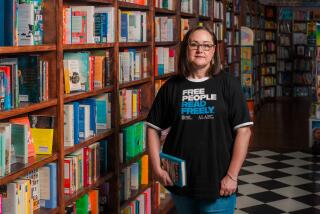Helping to Rediscover New World : Brown University Libraries Specialize in the Americas
- Share via
PROVIDENCE, R.I. — Are you a writer, researcher, scholar or film maker needing information about the Americas from the day Columbus first set foot in the New World?
Consider a visit to Brown University, founded in 1764, the seventh-oldest college in the nation. Hundreds of scholars and history buffs come here each year to tap the rich resources of the school’s libraries in the shadows of the capitol of the country’s smallest state.
For more than a century the university’s John Carter Brown Library, with its own endowment of $7 million, has been assembling a growing collection of materials about the discovery, exploration, settlement and development of the New World.
It contains the world’s largest collection of Revolutionary War pamphlets, an extensive collection of New World maps, the largest collection of books published in Mexico prior to 1600, and the largest collection of books about Brazil, Peru and Chile published before 1800. There is also a vast collection of books printed in the colonies and in Europe about ongoing activities in the New World.
The latter begins with a first edition of the rare Christopher Columbus letter of 1493 telling of the discovery of America. The library publishes a newsletter about Columbus regularly sent to 500 Columbus scholars and buffs.
Among the 2.5 million items in the university’s John Hay Library is the Caleb Fiske Harris collection of American poetry and plays, considered the most complete assemblage of its kind.
Curator Rosemary L. Cullen notes that 63% of all titles in the Standard Bibliography of American Poetry published prior to 1820 are here as well as 79% of the American plays prior to 1820.
There is poetry of many descriptions including collections of carriers’ addresses, single sheet poems published by newspapers and distributed by newsboys on New Year’s Day, a custom dating from 1720 to the early 1900s. The poetry would describe events of the just-completed year accompanied by a note requesting a gratuity for the carrier boy.
Military historians and film makers come to the John Hay Library to do research in the Ann S. K. Brown Military Collection of 30,000 books, 60,000 prints and 5,000 miniature lead soldiers, plus numerous drawings, watercolors and manuscripts devoted to military history.
“They use the collection as a prime resource for authentic reproductions of uniforms, descriptions of battles from every nation on Earth dating back to the earliest recorded times,” said curator Richard B. Harrington.
The John Hay Library is named after the university’s 1858 graduate who was a poet, private secretary to President Abraham Lincoln and later secretary of state and ambassador to Great Britain.
The library’s Lincoln collection includes life masks of the President, several famous original paintings, such as Alexander Hay Ritchie’s “The Death of President Lincoln,” busts, statues and 13,000 books about the Great Emancipator.
John D. Rockefeller Jr., a 1897 Brown alumnus, purchased the Lincoln collection in 1923 and presented it to the university. The main library on campus is named after Rockefeller.
“This really gives you a sense of history,” said Jennifer B. Lee, curator of the Lincoln collection, as she held the original muster roll of an 1832 Black Hawk War Regiment. It is one of more than 900 letters, manuscripts and documents written or signed by Lincoln in the collection.
“All of Hay’s personal papers are here,” noted Lee, “including his three-volume White House diary, a personal record of day-to-day events, behind-scenes conversations and impressions of people.”
Hay was 22 when he became Lincoln’s secretary, she said. “Lincoln used him as a sounding board. When the President could not sleep at night he would wake Hay up and talk to him about everything and anything, much of which Hay recorded in his diary.”
In the midst of the ivy-covered classrooms and libraries and the historic old gates on the Brown campus is a large mausoleum containing the remains of a Civil War general and his wife. It is yet another library.
The Annmary Brown Memorial contains the crypts of the two university benefactors as well as a world-famous collection of incunabula, books printed before the 16th Century and of prime importance to those who study medieval and renaissance culture.
In the crypts are the remains of Annmary Brown Hawkins, granddaughter of Nicholas Brown, the man the university is named after, and her husband, Gen. Rush Christopher Hawkins.
When his wife died in 1903, Hawkins erected the memorial to hold the remains of his wife, himself, his priceless books and his valuable paintings from the 17th, 18th and 19th centuries.
Readings and special programs are held regularly beside the two crypts, abiding by instructions in Hawkins’ will, said Catherine Denning, curator of the library.
The campus libraries are remarkable given the relatively small size of the school, said Merrily Taylor, university librarian. There are 5,400 undergraduates, 1,200 graduate students and 250 in the medical school.
There is another library adjacent to the Brown campus at 251 Benefit Street--the Providence Athenaeum, one of America’s oldest libraries dating back to 1753. It is here that Edgar Allen Poe courted poet Sarah Helen Whitman. Ralph Waldo Emerson, J.J. Audubon, Henry Wadsworth Longfellow and other men and women of letters are said to have been regular patrons.
More to Read
Sign up for Essential California
The most important California stories and recommendations in your inbox every morning.
You may occasionally receive promotional content from the Los Angeles Times.










